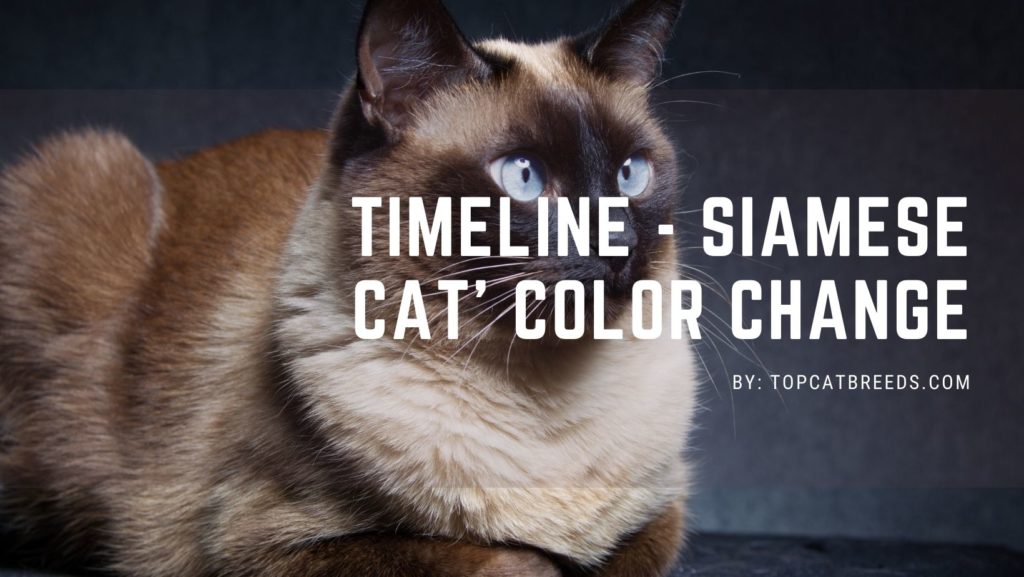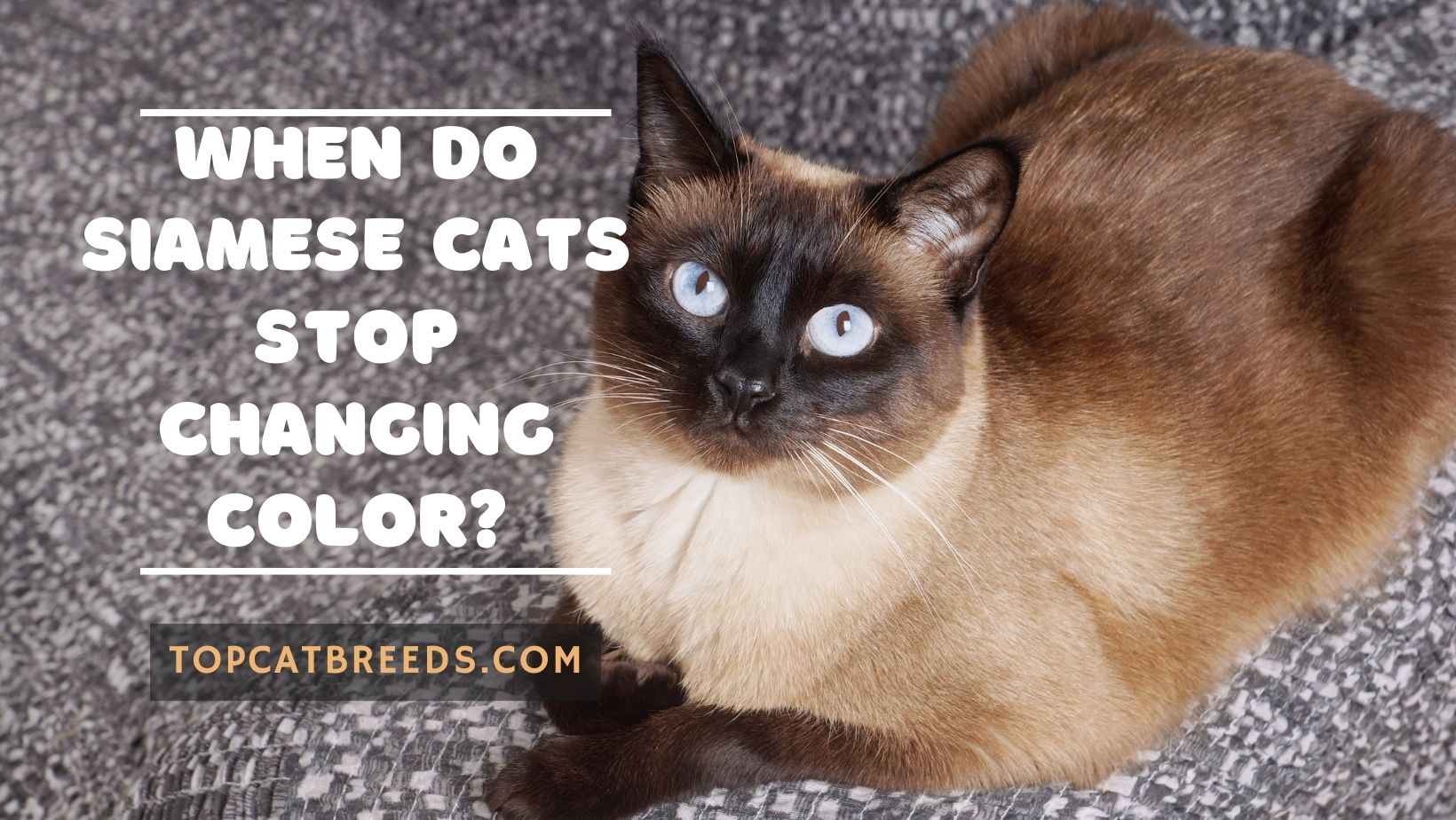
Siamese cats are probably one of the most interesting feline breeds around. They are tied to ancient Asian legends like the one about the golden goblet, and they also don’t have an exact origin year because of how old the breed is.
However, one specific feature that will surely pique your interest is how the color of their coats changes over time. Unlike others, they aren’t tied to simply being brown, black, or white. Sometimes, their color deepens, and in other instances, they lose some shades. It’s definitely something that you would want to keep track of.
Now, when do Siamese cats stop changing color? Does it stop at a certain age? Better yet, does the transition even stop? This is what we will try to answer in the following sections.
Why Do Siamese Cats Change In Color?
There are many reasons why your Siamese cat may be changing its fur color. Here are some of the most common ones that you should know:
Change In Temperature
Temperature is one of the largest factors that affect Siamese cats and their tendency to change their coat’s color. Hence, if it changes, may it get warmer or colder, you can expect that the feline’s fur will also transition into another shade sooner or later.
For reference, the fur of Siamese cats gets lighter in warmer temperatures, and darker when they are in a colder environment. This also explains why you may notice a significant change in their coat in certain seasons like summer and winter.
Weight Gain
The color of Siamese cats doesn’t change when they lose weight. However, tables totally turn when we talk about weight gain.
Because the adipose tissue of their body stores more fat and calories rather than veins, they tend to have a lower body temperature. Similarly, this pushes their body systems to change in a darker coat color to compensate for the necessary body heat.
Thus, the fatter the Siamese cat is, the darker they may become.
Illness
It’s a little uncommon, but there are actually some feline illnesses that can cause their coats to change color. These may include skin diseases like the late formation of albinism, allergic discoloration, and others that may be in relation to their body’s pigmentation system.
You don’t have to worry, though. It’s easy to know that this is the case if you notice that your cat is behaving unusually. You should also observe and contact a veterinarian as soon as possible if they seem to be in any kind of pain.
Diet And Lifestyle
Siamese cats need a balanced diet in order to have healthy coats. That said, it’s just right to conclude that it has a direct relationship with their color.
Their fur can either lighten or darken depending on whether they get enough nutrients from what they eat. For instance, if they don’t get enough tyrosine, expect that they will lean on darker coat shades in the long run. Overconsumption of melanin, on the other hand, may opt their bodies to change into a lighter coat.
Age
Age is an unavoidable aspect when it comes to the color-changing characteristics of Siamese cats. They will have a certain color as a newborn, transition into a different one when they grow as kittens, and continue changing into various shades even when they’re adult cats.
As they further age, expect that they will also get darker or greyer over time. It’s very similar to how we get grey hair when we get at a certain age.
How Long Does It Take For A Siamese Cat To Get Its Color?
A Siamese cat first starts getting its color between 10 to 12 days of age.
The time will depend on what their specific color will be over time. So, for instance, we’re talking about kittens that are more likely to have either seal point or blue point shades, expect that pigmentation can start when they’re around 10 days old. On the other hand, those with chocolate point and lilac point coats tend to start forming at about 12 days or more.
Keep in mind that this is still on a case-to-case basis. Their genes will play a part in the process. Thus, your kitten, no matter the color, may start showing visible signs of pigmentation earlier. Some may also start later.
Understanding The Timeline Of A Siamese Cat’ Color Change

To have a better view of the answer to “When do Siamese cats stop changing color?”, the first thing that you should look at is the timeline. It consists of when the feline transitions into another coat shade, what age they get their first color, and when you can expect it to change.
That said, here is a timeline that you can refer to:
Newborn
Newborn Siamese felines start with purely white coats. It’s because when they are just freshly out of the mother cat’s womb, their bodies temporarily retain heat, and stops any kind of pigmentation process from happening. This can last for a little more than a week or so.
After around ten days, you can expect to notice streaks of color on their heads. It will serve as an indication of what their future coat shades will be.
Kitten Stage
When Siamese kittens reach around 1 month old, they will generally show light shades of their coat colors on some of their body parts like their ears, legs, tails, and paws. Their face may also show signs of pigment around this time.
Some kittens may take at least 2 months before they can show initial signs of pigmentation. Give your kitten about 10 months to grow into their fur’s most dominating fur color.
Early Adulthood
A Siamese reaches the early adulthood stage when they reach 1 year old. Here, they are starting to grow into their full size and start developing pigmentation for the other parts of their body. They may also show signs of darker coat shades if that is what their dominating color is. At the same time, this stage is when you can expect your Siamese cat to fully develop their overall pigmentation.
Adult Cat Phase
More often than not, Siamese cats become an adult when they reach 2 years of age. At this time, they have complete development of their coat’s pigmentation, and, thus, you probably already know what color classification they fit in.
On the flip side, keep in mind that this is also when they start to constantly change colors depending on what they are feeling and where they are.
Senior Cat
Once a Siamese cat surpasses 10 years of age, they are then considered a senior feline. When they reach this stage, their fur coat tends to get darker over time. Some simply transition into deeper shades of their natural color, but others change into a grey coat as a sign of aging. This is something that will happen, no matter how well you take care of your feline.
Read also: Why Do Siamese Cats Have Crossed Eyes?
What Is The Rarest Siamese Color?
Currently, flame point Siamese cats are considered the rarest when it comes to coat color. This is also known as a red point coat. You can picture the coat coming in a light orange color.
Now the fur coat will probably be the result if you add a ton of white tones on a tabby cat, which actually makes sense since it’s the combination of the genes of a regular Siamese and a domestic tabby.
Because of how uncommon the color is, you can just expect that the price tag put on them is sky-high. They’re currently worth at least $400, which can still rise depending on the quality of the breed.
Why Is My Siamese Cat’s Fur Getting Darker?
As we have previously discussed, there are several factors that affect the color of a Siamese cat. This means that there are also a lot of possible things that can contribute to why their fur can suddenly darken.
To have a better view of this topic, below are some possible instances that may have happened to your feline:
Low Temperature
If you and your cat live in a cold place, or you two simply went up on a walk during a cold season, then this may be the reason why their fur may be getting darker. Low temperature has a tendency of affecting a Siamese cat’s pigmentation.
Weight Gain
Siamese cats also get darker fur whenever they gain weight. This is the reason why overweight cats usually tend to have a deeper color compared to malnourished and average-weight felines of the said breed.
Genetics
In some instances, Siamese cats may have genes that give them the tendency to develop a darker color for their coats even when they are past the adulthood stage. This is usually the case if you notice their fur getting darker for no particular reason.
Aging
Your Siamese cat may also get darker because they are starting to age up. This applies, no matter if we’re talking about a kitten or an already senior cat.
Food Rejection
If your Siamese has a sensitive appetite, and you notice their coat getting darker after eating, then there’s a possibility that their body is rejecting the food you gave. This usually happens when they eat herbs, bitter food, and likes. The liver is also one of the suspected culprits.
Do Siamese Cats Get Darker In The Winter?
The color of Siamese cats gets darker in winter. This is because temperature significantly affects the color of a Siamese cat’s fur, and a part of this change causes the coat to darken whenever it’s cold. It will continue to darken as the temperature lowers.
For the scientific explanation, they do this as a defense mechanism against cold and other related issues like hypothermia. The pigmentation speeds up as their bodies’ systems bring out the body heat they store through fats. This also explains why their coats transition back to lighter point shades once seasons get warmer.
Other instances when you may notice their fur get darker is when the Siamese cat gains weight, or when they grow older.
Wrapping Up
To answer the question, “When do Siamese cats stop changing color?” — it doesn’t.
Siamese cats don’t stop changing their colors since the process works through pigmentation. This means that although uncontrollable, it will still happen depending on several factors like the environment, temperature, age, body mass, and likes.
Hence, it’s safe to say that you wouldn’t lose the fun of being an owner of a Siamese cat. Take a good look at how their coat transitions from one shade to another over the years. You can even document it, so you can look back on your feline’s life over time.
Read also: Why Do Siamese Cats Bite So Much?

